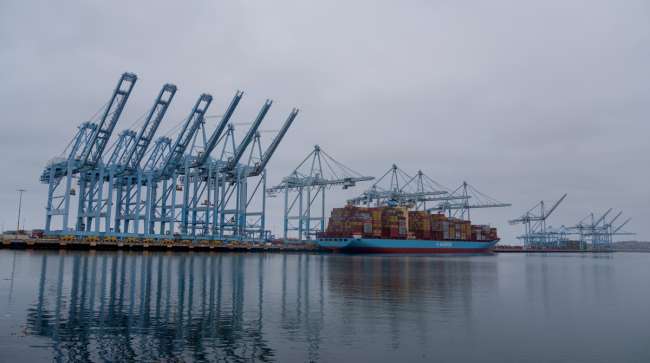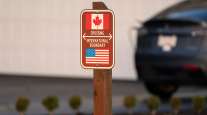Economists Race to Assess Trump’s Tariff Plans

[Stay on top of transportation news: Get TTNews in your inbox.]
President Donald Trump’s vow to unleash 25% tariffs on goods from Mexico and Canada has sent economists racing to estimate the impact on businesses and households across all three nations.
The potential fallout depends on the specifics of what Trump announces — the level of tariffs, the goods targeted or exempted and the duration they’re in place. It also depends on how Canada and Mexico respond.
Yet it’s already clear that if Trump does put new duties on the about $900 billion in goods from both nations, prices for everyday items from avocados and cars to energy are vulnerable to increases. Trump has also warned of imminent new tariffs on goods from China, meaning 42% of all U.S. imports could get hit with higher border taxes.
Here’s a snapshot of the early analysis ahead Trump’s Feb. 1 deadline:
Food Prices
Whether tariffs flow through to consumer prices will be a central variable that determines how Trump’s trade policy plays out, according to Paul Donovan, chief economist of UBS Global Wealth Management.
“How quickly would U.S. consumers experience higher prices? Oil and food prices would likely react within a month. U.S. stock levels determine the timing of other price increases. Second-round price increases also matter. These tariffs partially relate to the war on drugs, but if the political focus shifts to broader inflation perceptions, the duration of any taxes could be short. U.S. egg prices (a campaign focus) have soared since Trump was elected — food prices rather than drug prices may matter more.”
Purchasing Power
Hefty new tariffs would pose major risks for the Mexican peso and Canadian dollar, while driving up the U.S. dollar. But an early resolution would relieve pressure on the loonie and peso and driving down the dollar, according to analysts at ING.
“The new administration’s dealing of this U.S.-Canada-Mexico situation will likely be used by markets as a benchmark for Trump’s trade policy moving ahead, and should therefore have large repercussions for global FX.”
Farming & Fishing
Analysis by S&P Global Ratings shows that autos and electrical-equipment sectors are the most exposed to a tariff shock in Mexico, while Canada’s commodity processing sector would be hit. They estimate the U.S. has much less at risk in the event of retaliation though sees some exposure for farming, fishing, metals and autos.
“Comparing the U.S.’s output at risk with Canada’s and Mexico’s our scenario suggests that Mexico and Canada face impacts on their whole economies that are 11 times and 5 times higher, respectively, than the impact on the U.S.,” S&P analysts wrote in a note. When looking only at the top 10 affected industries, the average impact is still 6 times worse in Mexico and 5 times worse in Canada than in the U.S., they said.
Major Reshuffle
If Trump delivers on his promised tariffs 25% tariffs on Mexico and Canada and on his threat of 10% tariff hike on goods from China, it would increase the average U.S. tariff rate on all goods imports to more than 11% from 3% and spark a major reshuffling of global trade, according to Bloomberg Economics.
“We estimate that US imports of goods from Canada and Mexico could be down by close to 70% and from China by nearly 40% in the medium term, once economies have fully adjusted to the new conditions. U.S. imports from the rest of the world would increase, helping offset some of the decline — with Asian economies among the winners,” Bloomberg Economics wrote in a note.
Commodity Prices
A 25% tariff on Canadian imports into the U.S. would hit drive up commodity prices and hit profit margins for Canadian exporters. Production and investment in Canada would also suffer, according to Oxford Economics.
“Global primary aluminium prices would fall on softer global demand but higher Midwest premiums from tariffs would raise prices for US customers. The dominant share of the U.S. market in Canadian exports suggests diverting volumes to alternative markets will be difficult, resulting in squeezed margins and reduced output for Canadian producers. In comparison, a large U.S. domestic steel industry, and a lower dependence on Canadian imports would result in a smaller rise above baseline for U.S. steel prices.”
Three Scenarios
Goldman Sachs economists see three possible outcomes: a tariff with delayed implementation, or targeted at certain imports, or starting at a lower rate that rises over time — or some combination of these.
- A 25% tariff with delayed effect: Trump could announce the 25% tariff on Canada and Mexico with implementation two or three weeks later. This would leave time for negotiations among the three nations.
- A targeted 25% tariff: It is also possible that rather than providing a few exemptions on imports like oil, the tariff might apply to only a few sectors such as steel or autos. Such an approach could have a months-long lead time before implementation if a formal investigation is required.
- A phased-in approach: In 2019, the tariff that Trump announced on imports from Mexico would have started at 5% and increased gradually up to 25%.
Want more news? Listen to today's daily briefing below or go here for more info:




